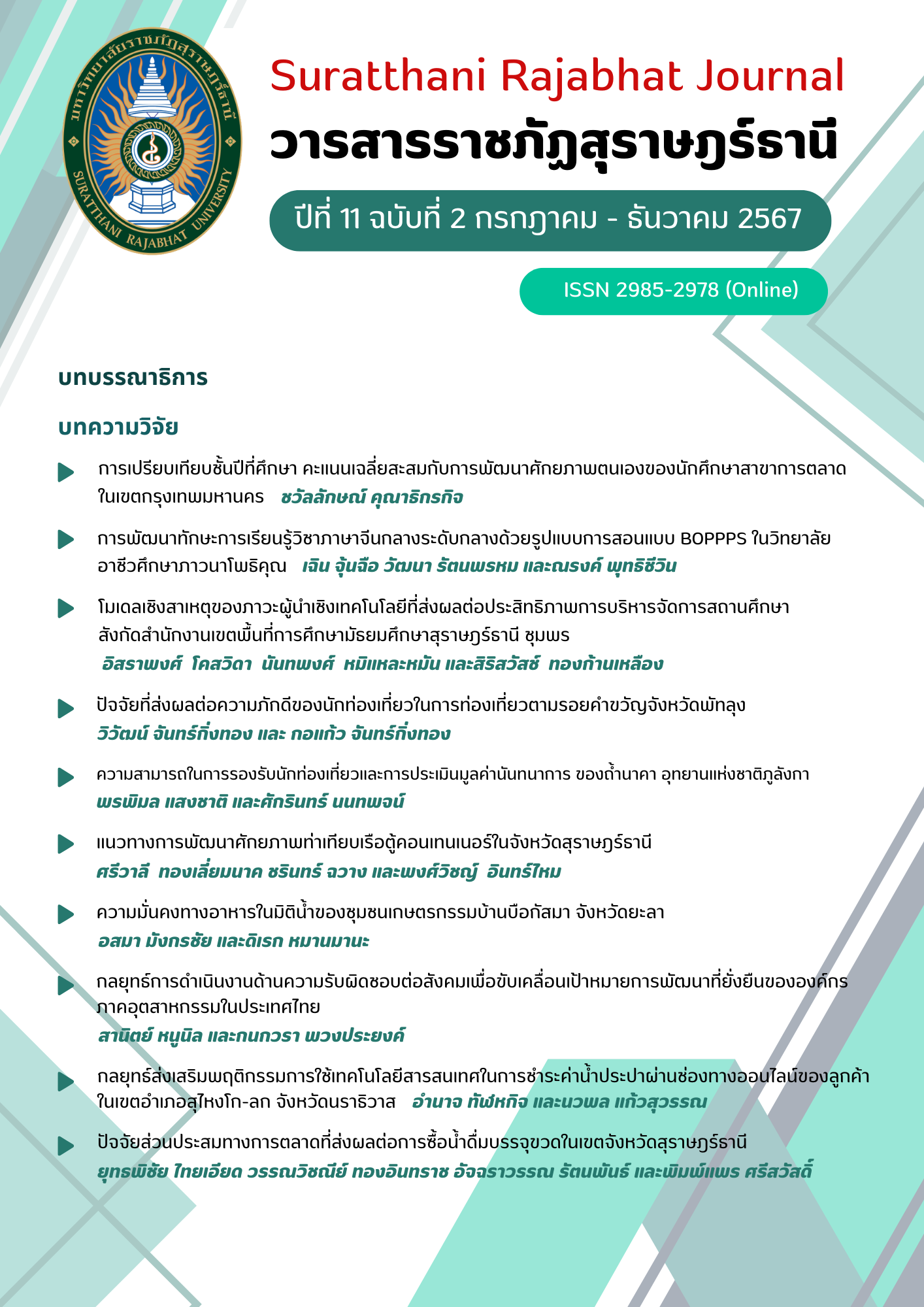ความสามารถในการรองรับนักท่องเที่ยวและการประเมิน มูลค่านันทนาการ ของถ้ำนาคา อุทยานแห่งชาติภูลังกา
Main Article Content
บทคัดย่อ
การศึกษานี้มีวัตถุประสงค์ 1) เพื่อศึกษาความสามารถในการรองรับนักท่องเที่ยวในการมาท่องเที่ยวที่ถ้ำนาคา อุทยานแห่งชาติภูลังกา 2) เพื่อประเมินมูลค่าการใช้ประโยชน์ด้านนันทนาการของถ้ำนาคา อุทยานแห่งชาติภูลังกา เป็นการวิจัยแบบผสมผสาน แบบแผนคู่ขนาน โดยเก็บข้อมูลจากผู้ให้ข้อมูลสำคัญ จำนวน 14 ท่าน จากการสัมภาษณ์เชิงลึก สำหรับการศึกษาถึงความสามารถในการรองรับนักท่องเที่ยว และแบบสอบถามจากกลุ่มตัวอย่าง 420 ชุด โดยการสุ่มอย่างง่าย ซึ่งจะทำการแจกแบบสอบถามให้แก่อาสาสมัคร และรับคืนแบบสอบถามด้วยตนเอง สำหรับการศึกษา เพื่อประเมินมูลค่าการใช้ประโยชน์ด้านนันทนาการด้วยวิธีการวิเคราะห์ถดถอยปัวซอง ผลการศึกษา พบว่า 1) ขีดความสามารถในการรองรับด้านกายภาพ สำหรับการประกอบกิจกรรมนันทนาการในพื้นที่เท่ากับ 118 คนต่อรอบ โดยแบ่งเป็น 8 รอบ หรือ 944 คนต่อวัน และยังพบปัญหาในการเดินทาง คือ จำนวนห้องน้ำไม่เพียงพอ เนื่องจากเป็นพื้นที่อุทยานจึงไม่สามารถสร้างสิ่งปลูกสร้างถาวรได้ และยังมีการเดินทางที่เป็นอุปสรรค เนื่องจากจำเป็นต้องเดินเท้าขึ้นไป โดยมีบันไดและทางธรรมชาติสลับเป็นช่วง และในบางจุด จำเป็นต้องใช้เชือกในการพยุงตัว 2) นักท่องเที่ยวที่เดินทางมาส่วนใหญ่มีความเชื่อในเรื่องของพญานาค โดยมีมูลค่าผลประโยชน์เชิงนันทนาการ ในปีงบประมาณ พ.ศ.2565 คิดเป็นส่วนเกินผู้บริโภคเท่ากับ 5,758 บาทต่อคนต่อครั้ง จากจำนวนนักท่องเที่ยว ชาวไทย 233,800 คนต่อปี หรือ 1,346,220,400 บาทต่อปี จากผลการศึกษาภาครัฐ 1) ควรมีนโยบายเพื่อตรวจสอบและควบคุมจำนวนนักท่องเที่ยวในแต่ละวันไม่ควรเกิน 944 คนต่อวัน โดยแบ่งเป็น 8 รอบต่อวัน ควรจำกัดเวลาในการเข้าชมต่อกลุ่มไม่เกิน 15 นาทีต่อกลุ่ม และควรกำหนดเวลาเริ่มต้นในการเดินขึ้นอย่างชัดเจน 2) ควรมีการเก็บค่าธรรมเนียมเพิ่มเติมในบางสถานที่ เพื่อนำมาเป็นส่วนในการฟื้นฟูอนุรักษ์ทรัพยากรธรรมชาติ ซึ่งควรศึกษาถึงการเพิ่มโอกาสในการเข้าถึงสำหรับผู้สูงอายุ และควรมีการส่งเสริมรายการนำเที่ยวตามเส้นทางตามความเชื่อในพื้นที่บริเวณใกล้เคียงให้มีความเชื่อมโยงกัน
Article Details

This work is licensed under a Creative Commons Attribution-NonCommercial-NoDerivatives 4.0 International License.
References
Aphihirantrakun, C. (2021). Tourism Attraction Carrying Capacity Assessment in Mae Ngao National Park, Mae Hong Son Province. Research and Development Journal, Loei Rajabhat University, 17(59), 41-51, (in Thai). https://so05.tci-thaijo.org/index.php/researchjournal-lru/.
Bank of Ayudhya. (2021). Tourism and hotel business after COVID-19, (in Thai). https://www.krungsri.com/th/research/research-intelligence/ri-future-of-tourism-21.
Bunta, J., Suksaard, S. & Huamueangkaew, W. (2012). Recreational value of Erawan National Park. Kanchanaburi Province. Forestry Journal, 31(2), 72-83, (in Thai). https://kukrdb.lib.ku.ac.th/journal/JFOR/search_detail/result/50715
Cowen, T. (2007). Public goods. https://en.wikipedia.org/wiki/Public_good_(economics).
Department of National Parks Wildlife and Plant Conservation. (2021). Statistic for National Parks Wildlife and Plant, (in Thai). http://park.dnp.go.th/visitor/indexstatistics.php.
Ewasakul, N. (2010). Recreational valuation and carrying capacity: a case study of bangsaen beach, chonburi. http://www.thaithesis.org/detail.php?Id=1202548000638.
Inchai, M., Kungwon, S., Ngamsomsuke, W., & Tantranont, N. (2017). Valuation of Recreational Benefits of Natural Tourism Sites : A Case Study of the Decline in Quality of Tourism Si. Journal of Economics Chiang Mai University, 21(1), 31-52. (in Thai). https://so01.tci-thaijo.org/index.php/CMJE/article/view/76497.
Jantarawimin, N. (2010). an evaluation of recreation benefits : soi phranang discovery learning library ratchathewi district bangkok. (in Thai). http://thesis.swu.ac.th/swuthesis/Hum_Res_Econ/Noppamon_J.pdf.
Katsakarn, R., Charungsutjaritkul, W., Jarapong, K. & Chumtongdo, S. (2022). Economic valuation of tourism at wat chedi, sichon district nakhon si thammarat province. Journal of MCU Nakhondhat, 9(7), 119-134. https://so03.tci-thaijo.org/index.php/JMND/article/view/262563/174537.
Kitsanarom, N. & Nakaray., P. (2021). The Development in Community Based-tourism to the suitable with the Behavior andNeed of the Tourism in Noppitham, Nakhon Si Thammarat Province. Nagabutr Journal Nakhon Si Thammarat Rajabhat University, 13(1), 128-140, (in Thai). http://dspace.nstru.ac.th:8080/dspace/handle/123456789/2442?mode=full.
Lindsay, J. J. (1986). Carrying capacity for tourism development in national parks of the United States. Ind. Environ, 9(1), 17–20.
Mathayomburut, W. (2019). Structure of Tourism System. Journal of Thai Hospitality and Tourism, 14(1), 94-102, (in Thai). http://www.Tourismtaat.siam.edu/images/magazine/m14b1/07.taat.pdf.
Mathieson, A. & Wall, G. (1982). Tourism: Economic, physical, and social impacts. London, New York: Longman.
Mertens, D. M. (2005). Research and Evaluation in Education and-Psychology: Integrating diversity with Quantitative, Qualitative, and Mixed Methods (pp.2 & 88-189). Thousand Oaks, London, Sage press.
Nonthapot, S. & Sirimat, S. (2020). The risk factors affecting people after the border conflict between thailand and cambodia at the baan phum sarol village, kantharalak district, sisaket province, thailand. Palarch’s Journal Of Archaeology Of Egypt/Egyptology, 17(10), 780-792. https://www.researchgate.net/publication/348804774_THE_RISK_FACTORS_AFFECTING_PEOPLE_AFTER_THE_BORDER_CONFLICT_BETWEEN_THAILAND_AND_CAMBODIA_AT_THE_BAAN_PHUM_SAROL_VILLAGE_KANTHARALAK_DISTRICT_SISAKET_PROVINCE_THAILAND_PJAEE_17_10_2020_780_THE_RISK_FA.
Phewmau, K. (2012). Recreational Valuation of the Coral Diving Activities at Mu Kho Similan NationalPark, Phang-nga Province, (in Thai). https://archive.lib.cmu.ac.th/full/T/2555/econ41055kp_abs.pdf.
Phongsakornrangsin, P., Empan, D. & Arunpraparat, W. (2019). Determination of tourism carrying capacity of enhancing tourism destination management standard at Mu Koh Lanta, Krabi Province. (in Thai). https://digital.library.tu.ac.th/tu_dc/frontend/Info/item/dc:172017.
Phumsathan, S., Nisaiharn, J. & Songsaeng, N. (2021). Physical carrying capacity and recreational use level at than bok khorani national park, krabi province. Journal of Environmental Management, 15(2). 6-25. (in Thai). https://so02.tci-thaijo.org/index.php/JEM/article/view/218010.
Rasri, S. (2015). Information technology in human resource management at the zoological park organization, bangkok, thailand. (in Thai). http://ethesisarchive.library.tu.ac.th/thesis/2015/TU_2015_5703010339_3789_3270.pdf.
Ratchatawetkol, W. (2013). Using information technology with human resource management. Case study: Zoo organization. (in Thai). https://repository.nida.ac.th/server/api/core/bitstreams/fd71ae81-81be-4794-86b5-4ebda5945de8/content.
Sripaoraya, M. & Rungklin, D. (2020). Assessing the recreational value of coral resources in Ang Thong National Marine Park. Journal of Management Science, 7(1), (in Thai). 175-201. https ://so03.tcithaijo.org/I ndex.php/msj/article/download/133084/165004.
Sritrakul, W. (2021). Ai Khai Wat Chedi Phenomenon” Behavior, Beliefs and Rituals. (in Thai). https://archive.cm.mahidol.Ac.th/handle/123456789/4283.
Sukiam, K. & Suthipisan, S. (2021). A guideline for effecttive conservation and development of phra nakhon khiri park (khao wang). Journal of Liberal Arts and Management Science Kasetsart University, 8(1). 83-93. (in Thai). https://kuojs.lib.ku.ac.th/index.php/jfam/article/view/4976.
Texas Parks and Wildlife. (2018). Texas Outdoor Recreation Plan. Austin: TPWD.
Thareesang, K. & Thaweewat, P. (2017). The Evaluation of Recreational Use Value of Si Racha Seaside Public Park. Journal of Economics and Management Strategy, 4(1), 25-33. (in Thai). https://kukrdb.lib.ku.ac.th/journal/JEMS/search_detail/result/20001373.
Thairath Online. (2021). Do you believe in the story of the Naga, "Naga Cave", a legend told of the power of faith for travelers in the Mu line, (in Thai). https://www.thairath.co.th/news/society/2237538.
Thampitak, K. & Anthong, A. (2011). An Evaluation of Recreational Benefits of Nong Leng Sai Wetland. CMU Journal ECON, 15(2), 70-89. https://so01.tci-thaijo.org/index.php/CMJE/article/view/61233.
Waltz, C. F., Strickland, O. L. & Lenz, E. R. (2005). Measurement in nursing and health research, New York: Springer. 3.
Wongpakdee, B. (2009). Capacity to support recreational use of Khao Chamao-Khao Wong National Park. Kasetsart University:Bangkok. https://doi.nrct.go.th/ListDoi/listDetail?Resolve_DOI=10.14457/KU.the.2009.714.
Wongmahadlek, P., Kittiprasan, K., Trumikaborworn, K., & Rungwawang, K. (2019). An Applied Recreational Opportunity Spectrum (ROS) and Carrying Capacity Assessment for Tourism Destination Management: A Case of Kood Island. NAJUA: Architecture, Design and Built Environment, 34(1), 1-20. https://so04.tci-thaijo.org/index.php/NAJUA-Arch/article/view/190393/145468.

